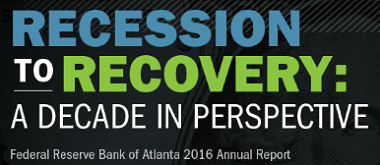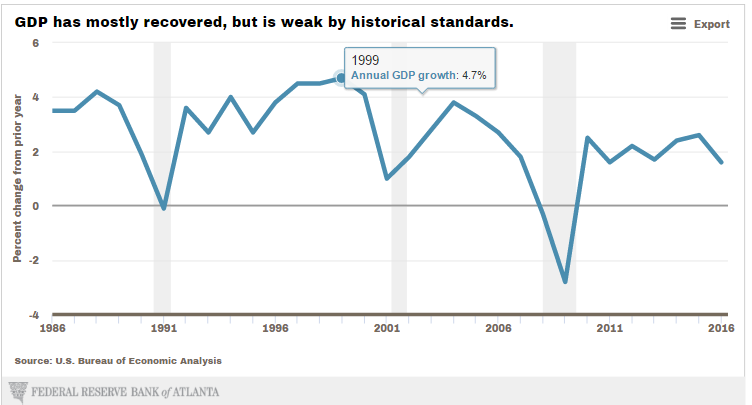from the Atlanta Fed
The Cyclical Recovery
In the complex U.S. economy, trends do not often fit cleanly into categories such as cyclical and secular. Broadly speaking, though, it is possible to classify certain developments as mainly cyclical and others as more persistent, or secular.

As the video explained, we have experienced a cyclical economic recovery. Let’s delve deeper into cyclical elements of the economy that have, by and large, rebounded.
Macroeconomy
Annual GDP growth is a sort of speedometer for the nation’s economy.
Start with the broadest gauge of the nation’s entire economy. Gross domestic product, or GDP, is a monetary measure of the value of all final goods and services produced. In 2016, GDP in the United States totaled roughly $18.9 trillion, according to the U.S. Bureau of Economic Analysis. Another important macroeconomic indicator is inflation, which has been below the central bank’s 2 percent target throughout the recovery.

Congress established the Federal Reserve’s monetary policy objectives of maximum employment and stable prices in the Federal Reserve Act. These legislated objectives are often referred to as the “dual mandate.”
Note that in charts, gray bars indicate recessions.

Turning to the overall economy, GDP growth since the Great Recession has been weak by historical standards. Burdened by the depth and duration of the recession, the severe financial crisis, and various secular factors discussed later, annual real GDP growth since the end of the last recession has hovered around 2 percent. In contrast, within three years after the previous six recessions, annual GDP growth had reached almost 4 percent.
Labor Market
The labor market: More of us are working than ever.
Businesses have been hiring at a solid pace despite tepid growth in output. Consequently, aggregate employment has staged a reasonably robust cyclical recovery from a bruising downturn.













Leave A Comment